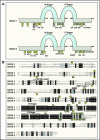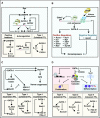The GATA factor revolution in hematology
- PMID: 28179282
- PMCID: PMC5391619
- DOI: 10.1182/blood-2016-09-687871
The GATA factor revolution in hematology
Abstract
The discovery of the GATA binding protein (GATA factor) transcription factor family revolutionized hematology. Studies of GATA proteins have yielded vital contributions to our understanding of how hematopoietic stem and progenitor cells develop from precursors, how progenitors generate red blood cells, how hemoglobin synthesis is regulated, and the molecular underpinnings of nonmalignant and malignant hematologic disorders. This thrilling journey began with mechanistic studies on a β-globin enhancer- and promoter-binding factor, GATA-1, the founding member of the GATA family. This work ushered in the cloning of related proteins, GATA-2-6, with distinct and/or overlapping expression patterns. Herein, we discuss how the hematopoietic GATA factors (GATA-1-3) function via a battery of mechanistic permutations, which can be GATA factor subtype, cell type, and locus specific. Understanding this intriguing protein family requires consideration of how the mechanistic permutations are amalgamated into circuits to orchestrate processes of interest to the hematologist and more broadly.
© 2017 by The American Society of Hematology.
Figures




References
-
- Evans T, Felsenfeld G. The erythroid-specific transcription factor Eryf1: a new finger protein. Cell. 1989;58(5):877-885. - PubMed
-
- Tsai SF, Martin DI, Zon LI, D’Andrea AD, Wong GG, Orkin SH. Cloning of cDNA for the major DNA-binding protein of the erythroid lineage through expression in mammalian cells. Nature. 1989;339(6224):446-451. - PubMed
-
- Yamamoto M, Ko LJ, Leonard MW, Beug H, Orkin SH, Engel JD. Activity and tissue-specific expression of the transcription factor NF-E1 multigene family. Genes Dev. 1990;4(10):1650-1662. - PubMed
-
- Dorfman DM, Wilson DB, Bruns GA, Orkin SH. Human transcription factor GATA-2. Evidence for regulation of preproendothelin-1 gene expression in endothelial cells. J Biol Chem. 1992;267(2):1279-1285. - PubMed
Publication types
MeSH terms
Substances
Grants and funding
LinkOut - more resources
Full Text Sources
Other Literature Sources
Medical

